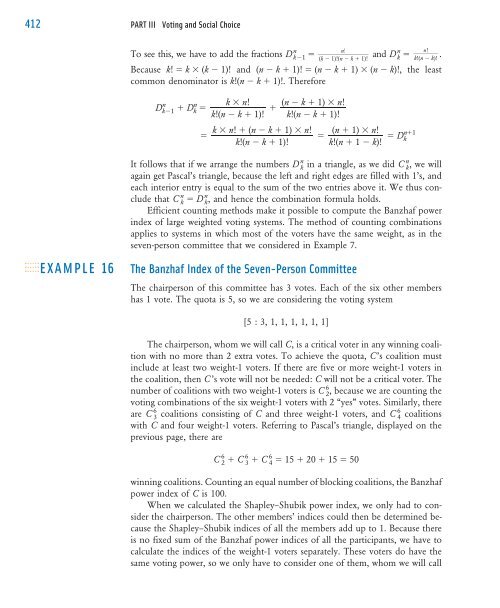Weighted Voting Systems - W.H. Freeman
Weighted Voting Systems - W.H. Freeman
Weighted Voting Systems - W.H. Freeman
- No tags were found...
You also want an ePaper? Increase the reach of your titles
YUMPU automatically turns print PDFs into web optimized ePapers that Google loves.
412 PART III <strong>Voting</strong> and Social Choicen!(k 1)!(n k 1)!n!k!(n k)!To see this, we have to add the fractions D n k1 and Dn k .Because k! k (k 1)! and (n k 1)! (n k 1) (n k)!, the leastcommon denominator is k!(n k 1)!. ThereforeEXAMPLE 16It follows that if we arrange the numbers D n k in a triangle, as we did C n k , we willagain get Pascal’s triangle, because the left and right edges are filled with 1’s, andeach interior entry is equal to the sum of the two entries above it. We thus concludethat C n k D n k , and hence the combination formula holds.Efficient counting methods make it possible to compute the Banzhaf powerindex of large weighted voting systems. The method of counting combinationsapplies to systems in which most of the voters have the same weight, as in theseven-person committee that we considered in Example 7.The Banzhaf Index of the Seven-Person CommitteeThe chairperson of this committee has 3 votes. Each of the six other membershas 1 vote. The quota is 5, so we are considering the voting system[5 : 3, 1, 1, 1, 1, 1, 1]The chairperson, whom we will call C, is a critical voter in any winning coalitionwith no more than 2 extra votes. To achieve the quota, C’s coalition mustinclude at least two weight-1 voters. If there are five or more weight-1 voters inthe coalition, then C ’s vote will not be needed: C will not be a critical voter. Thenumber of coalitions with two weight-1 voters is C 6 2 , because we are counting thevoting combinations of the six weight-1 voters with 2 “yes” votes. Similarly, thereare C 6 3 coalitions consisting of C and three weight-1 voters, and C 6 4 coalitionswith C and four weight-1 voters. Referring to Pascal’s triangle, displayed on theprevious page, there areC 6 2 C 6 3 C 6 4 15 20 15 50winning coalitions. Counting an equal number of blocking coalitions, the Banzhafpower index of C is 100.When we calculated the Shapley–Shubik power index, we only had to considerthe chairperson. The other members’ indices could then be determined becausethe Shapley–Shubik indices of all the members add up to 1. Because thereis no fixed sum of the Banzhaf power indices of all the participants, we have tocalculate the indices of the weight-1 voters separately. These voters do have thesame voting power, so we only have to consider one of them, whom we will call
















